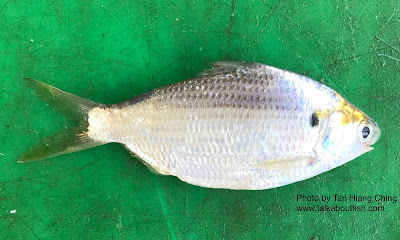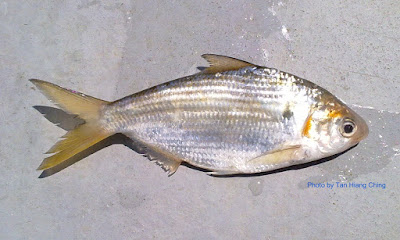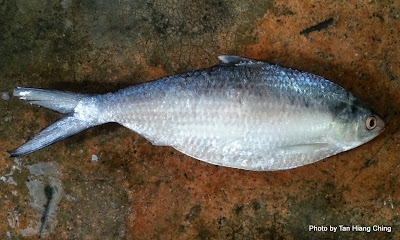Clupeids (Shad)
Herrings, shads, sardines, sprats, and menhadens are common names for members of the Clupeidae family. These fishes are small to moderate sized fishes ranging from 2 cm to 75 cm and are distinguished by their terminal mouth, scutes along the abdomen, and pelvic fin positioned vertically below the dorsal fin.
Clupeids are found in oceans worldwide, from approximately 70°N to 60°S. While they are predominantly marine species, they also inhabit brackish and freshwater environments. Most clupeids live in shallow coastal waters and estuaries, often forming large schools. They primarily feed on small planktonic organisms.
Globally, there are about 54 genera and 200 species of Clupeidae. In Malaysia alone, there are 12 genera and approximately 29 species.
On this website, the Clupeidae family is categorized by shape, size, and common names. This page focuses specifically on members commonly known as shads and gizzard shads.
Clupeids are found in oceans worldwide, from approximately 70°N to 60°S. While they are predominantly marine species, they also inhabit brackish and freshwater environments. Most clupeids live in shallow coastal waters and estuaries, often forming large schools. They primarily feed on small planktonic organisms.
Globally, there are about 54 genera and 200 species of Clupeidae. In Malaysia alone, there are 12 genera and approximately 29 species.
On this website, the Clupeidae family is categorized by shape, size, and common names. This page focuses specifically on members commonly known as shads and gizzard shads.
Scientific Name: Anodontostoma chacunda (Hamilton, 1822)
English Name: Shortnose Gizzard Shad, Chacunda Gizzard Shad
Chinese Name | 鱼类中文名: 无齿鰶 (Wú chǐ jì)
Malay Name | Nama Melayu Malaysia: Ikan Kebasi Kuasi, Selangat, Trubala
Thai Name | ชื่อสามัญภาษาไทย: ปลาตะเพียนน้ำเค็ม (Plā tapheīyn n̂ảkhĕm), ปลาโคก (Plā khok)
Local Hokkien: Bok Kok Hu
Main Identification Features: Snout prominent, about 3/4 of eye. Maxilla reaches a little farther than anterior border of pupil. Silvery, upper half darker with indistinct brown longitudinal lines, running along the rows of scales. A black spot on the shoulder. Fins hyaline.
Size: Maximum standard length 22 cm, commonly 14 cm.
Habitat and Ecology: Coastal and estuarine waters, to 50 m depth. Feeds on diatoms, radiolarians, molluscs, copepods, and crustaceans.

Scientific Name: Hilsa kelee (Cuvier, 1829)
English Name: Kelee Shad
Chinese Name | 鱼类中文名: 鲥鱼(Shí yú), 花点鲥 (Huā diǎn shí)
Malay Name | Nama Melayu Malaysia: Ikan Tiram, Kakak, Selangat, Terubok, Tamban Tiram, Empirit
Thai Name | ชื่อสามัญภาษาไทย: ปลาตะลุมพุกจุด (Plā talumphuk cud)
Main Identification Features: Body fairly deep and compressed. Abdomen with sharply-keeled scutes. Mouth terminal; upper jaw with a distinct median notch or cleft. Black spot behind upper operculum, often with up to 10 faint spots on midlateral sides.
Size: Maximum standard length 25 cm, commonly between 15 and 18 cm.
Habitat and Ecology: Coastal and estuarine waters, to 50 m depth. Feeds mostly on phytoplankton, but also on copepods, molluscan and crustacean larvae, prawns, amphipods, and polychaetes.

Scientific Name: Nematalosa japonica Regan, 1917
English Name: Japanese Gizzard Shad
Malay Name | Nama Melayu Malaysia: Ikan Kebasi, Selangat Jepun
Thai Name | ชื่อสามัญภาษาไทย: ปลาโคก (Plā khok)
Local Hokkien: Bok Kok Hu
Main Identification Features: Body more slender than in other Nematalosa species. Anterior arm of pre-operculum with a fleshy triangle above, not covered by third infra-orbital bone. A dark spot behind gill opening.
Size: Maximum standard length about 19 cm.
Habitat and Ecology: Nearshore over sand or mud, to 16 m depth. A filter-feeder, taking on algae or organic matter.

Scientific Name: Tenualosa toli (Valenciennes, 1847)
English Name: Toli Shad
Malay Name | Nama Melayu Malaysia: Ikan Terubok, Terubuk Jantan, Terubuk Mulut Besar, Terubok Sungai
Thai Name | ชื่อสามัญภาษาไทย: ปลาตะลุมพุก (Plā talumphuk)
Local Hokkien: Chi Kak Hu
Main Identification Features: Body moderately deep, compressed, ventraledge very thin with strong scutes. Caudal fin deeply forked, but relatively short, 31 to 34% of standard length. A diffuse dark mark behind gill opening may be present.
Size: : Maximum standard length 50 cm, commonly between 30 and 40 cm.
Habitat and Ecology: Coastal and estuarine waters, to 50 m depth. Feeds mainly by filter-feeding, but also by grubbing on muddy bottoms. Diet includes diatoms, protozoans, crustaceans, molluscs, and tunicates. A protandrous hermaphrodite species that reaches maturity as a male in year 1, spawns, and changes sex at year 2 to female. Spawns during the dry season in the middle reaches of the rivers.

English Name: Shortnose Gizzard Shad, Chacunda Gizzard Shad
Chinese Name | 鱼类中文名: 无齿鰶 (Wú chǐ jì)
Malay Name | Nama Melayu Malaysia: Ikan Kebasi Kuasi, Selangat, Trubala
Thai Name | ชื่อสามัญภาษาไทย: ปลาตะเพียนน้ำเค็ม (Plā tapheīyn n̂ảkhĕm), ปลาโคก (Plā khok)
Local Hokkien: Bok Kok Hu
Main Identification Features: Snout prominent, about 3/4 of eye. Maxilla reaches a little farther than anterior border of pupil. Silvery, upper half darker with indistinct brown longitudinal lines, running along the rows of scales. A black spot on the shoulder. Fins hyaline.
Size: Maximum standard length 22 cm, commonly 14 cm.
Habitat and Ecology: Coastal and estuarine waters, to 50 m depth. Feeds on diatoms, radiolarians, molluscs, copepods, and crustaceans.
Scientific Name: Hilsa kelee (Cuvier, 1829)
English Name: Kelee Shad
Chinese Name | 鱼类中文名: 鲥鱼(Shí yú), 花点鲥 (Huā diǎn shí)
Malay Name | Nama Melayu Malaysia: Ikan Tiram, Kakak, Selangat, Terubok, Tamban Tiram, Empirit
Thai Name | ชื่อสามัญภาษาไทย: ปลาตะลุมพุกจุด (Plā talumphuk cud)
Main Identification Features: Body fairly deep and compressed. Abdomen with sharply-keeled scutes. Mouth terminal; upper jaw with a distinct median notch or cleft. Black spot behind upper operculum, often with up to 10 faint spots on midlateral sides.
Size: Maximum standard length 25 cm, commonly between 15 and 18 cm.
Habitat and Ecology: Coastal and estuarine waters, to 50 m depth. Feeds mostly on phytoplankton, but also on copepods, molluscan and crustacean larvae, prawns, amphipods, and polychaetes.

Scientific Name: Nematalosa japonica Regan, 1917
English Name: Japanese Gizzard Shad
Malay Name | Nama Melayu Malaysia: Ikan Kebasi, Selangat Jepun
Thai Name | ชื่อสามัญภาษาไทย: ปลาโคก (Plā khok)
Local Hokkien: Bok Kok Hu
Main Identification Features: Body more slender than in other Nematalosa species. Anterior arm of pre-operculum with a fleshy triangle above, not covered by third infra-orbital bone. A dark spot behind gill opening.
Size: Maximum standard length about 19 cm.
Habitat and Ecology: Nearshore over sand or mud, to 16 m depth. A filter-feeder, taking on algae or organic matter.

Scientific Name: Tenualosa toli (Valenciennes, 1847)
English Name: Toli Shad
Malay Name | Nama Melayu Malaysia: Ikan Terubok, Terubuk Jantan, Terubuk Mulut Besar, Terubok Sungai
Thai Name | ชื่อสามัญภาษาไทย: ปลาตะลุมพุก (Plā talumphuk)
Local Hokkien: Chi Kak Hu
Main Identification Features: Body moderately deep, compressed, ventraledge very thin with strong scutes. Caudal fin deeply forked, but relatively short, 31 to 34% of standard length. A diffuse dark mark behind gill opening may be present.
Size: : Maximum standard length 50 cm, commonly between 30 and 40 cm.
Habitat and Ecology: Coastal and estuarine waters, to 50 m depth. Feeds mainly by filter-feeding, but also by grubbing on muddy bottoms. Diet includes diatoms, protozoans, crustaceans, molluscs, and tunicates. A protandrous hermaphrodite species that reaches maturity as a male in year 1, spawns, and changes sex at year 2 to female. Spawns during the dry season in the middle reaches of the rivers.
